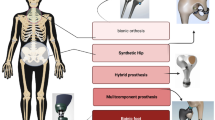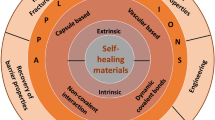Summary
Several methods of chemical fixation of avian physeal cartilage were compared. The Ruthenium hexammine trichloride method was compared to isotonic glutaraldehyde and neutral buffered formalin for light microscopy and paraffin embedment, and to two osmium-ferrocyanide methods and a combination of 1% glutaraldehyde and 4% formaldehyde for electron microscopy. Only the Ruthenium hexammine trichloride method prevented the loss of matrix proteoglycans and shrinkage of chondrocytes. In undecalcified paraffin-embedded cartilage, preservation of matrix and cellular detail was excellent, but Ruthenium hexammine trichloride interfered with Haematoxylin and Eosin staining. Glutaraldehyde gave more intense eosinophilia than neutral buffered formalin. Ultrastructurally, the Ruthenium hexammine trichloride method was the most consistent and gave the best overall fixation. Matrix elements and cellular and nuclear membranes were well preserved. It did result in vacuolation of the cytoplasm and mitochondria, and it increased granularity of the cytoplasm, chromatin, and rough endoplasmic reticulum. Other fixatives produced minimal vacuolation and finer granularity, but preservation was less consistent, cell/matrix contrast was often excessive, and they caused shrinkage of all chondrocytes. Large dilatations of the rough endoplasmic reticulum that appear to be cytoplasmic inclusions by light microscopy are described for the first time in avian cartilage.
Similar content being viewed by others
References
Akisaka, T., Kawaguchi, H., Subita, G. P., Shigenaga, Y. &Gay, C. V. (1988a) Ultrastructure of matrix vesicles in chick growth plate as revealed by quick freezing and freeze substitution.Calcif. Tissue Int. 42, 383–93.
Akisaka, T., Subita, G. P. &Shigenaga, Y. (1988b) Surface modifications at the periosseus region of chick osteoclast as revealed by freeze-substitution.Anat. Rec. 222, 323–32.
Björnsson, S. &Heinegård, D. (1981) Assembly of proteoglycan aggregates in cultures of chondrocytes from bovine tracheal cartilage.Biochem. J. 199, 17–29.
Bone, Q. &Ryan, K. P. (1972) Osmolarity of osmium tetroxide and glutaraldehyde fixatives.Histochem. J. 4, 331–47.
Carlson, C. S., Hilley, H. D. &Meuten, D. J. (1989) Degeneration of cartilage canal vessels associated with lesions of osteochondrosis in swine.Vet. Pathol. 26, 47–54.
Engfeldt, E. &Hjertquist, S. O. (1968) Studies on the epiphyseal growth zone. I. The preservation of acid glycosaminoglycans in tissues in some histotechnical procedures for electron microscopy.Virchows Arch. [B] 1, 222–9.
Farnum, C. E. &Wilsman, N. J. (1983) Pericellular matrix of growth plate chondrocytes: a study using postfixation with osmium-ferrocyanade.J. Histochem. Cytochem. 31, 765–75.
Farnum, C. E. &Wilsman, N. J. (1986) Ultrastructural histochemical evaluation of growth plate cartilage matrix from healthy and osteochondritic swine.Am. J. Vet. Res. 47, 1105–15.
Farnum, C. E. &Wilsman, N. J. (1987) Morphologic stages of the terminal hypertrophic chondrocyte of growth plate cartilage.Anat. Rec. 219, 221–32.
Fell, H. B. (1925) The histogenesis of cartilage and bone in the long bones of the embryonic fowl.J. Morphol. Physiol. 40, 417–59.
Hargest, T. E., Gay, C. V., Schraer, H. &Wasserman, A. J. (1985a) Vertical distribution of elements in cells and matrix of epiphyseal growth plate cartilage determined by quantitative electron probe analysis.J. Histochem. Cytochem. 33, 275–86.
Hargest, T. E., Leach, R. M. &Gay, C. V. (1985b) Avian tibial dyschondroplasia. I. Ultrastructure.Am J. Pathol. 119, 175–90.
Haynes, J. S. &Walser, M. M. (1986) Ultrastructure ofFusarium-induced tibial dyschondroplasia in chickens: a sequential study.Vet. Pathol. 23, 499–505.
Haynes, J. S., Walser, M. M. &Lawler, E. M. (1985) Morphogenesis ofFusarium sp-induced tibial dyschondroplasia in chickens.Vet. Pathol. 22, 629–36.
Hopwood, D. (1973) Theoretical and practical aspects of glutaraldehyde fixation. InFixation in Histochemistry (edited byStoward, P. J.) pp. 47–83. London: Chapman and Hall.
Howlett, C. R. (1973) The fine structure of the proximal growth plate of the avian tibia.J. Anat. 128, 377–99.
Howlett, C. R. (1980) The fine structure of the proximal growth plate and metaphysis of the avian tibia: endochondral osteogenesis.J. Anat. 130, 745–68.
Hunziker, F. B. &Schenk, R. K. (1984) Cartilage ultrastructure after high pressure freezing, freeze substitution, and low temperature embedding. II. Intercellular matrix ultrastructure-p-preservation of proteoglycans in their native state.J. Cell Biol. 98, 277–82.
Hunziker, E. B. &Schenk, R. K. (1987) Structural organization of proteoglycans in cartilage. InBiology of Proteoglycans (edited byWight, T. N. &Mecham, R. P.) pp. 155–85. Orlando, San Diego, New York, Austin, Boston, London, Sydney, Tokyo, Toronto: Academic Press, Inc.
Hunziker, E. B., Herrmann, W. &Schenk, R. K. (1982) Improved cartilage fixation by ruthenium hexammine trichloride (RHT): a prerequisite for morphometry in growth cartilage.J. Ultrastruct. Res. 81, 1–12.
Hunziker, E. B., Herrmann, W. &Schenk, R. K. (1983) Ruthenium hexammine trichloride (RHT)-mediated interaction between plasmalemmal components and pericellular matrix proteoglycans is responsible for the preservation of chondrocytic plasma membranesin situ during cartilage fixation.J. Histochem. Cytochem. 31, 717–27.
Hunziker, E. B., Herrmann, W., Schenk, R. K., Mueller, M. &Moor, H. (1984) Cartilage ultrastructure after high pressure freezing, freeze substitution, and low temperature embedding. I. Chondrocyte ultrastructure-implications for the theories of mineralization and vascular invasion.J. Cell Biol. 98, 267–76.
Hwang, W., McQueen, D., Monson, R. C. &Reed, M. H. (1982) The significance of cytoplasmic chondrocyte inclusions in multiple osteochondromatosis, solitary osteochondromas, and chondrodysplasias.Am. J. Clin. Pathol. 78, 89–91.
Kashiwa, H. K., Luchtel, D. I. &Park, H. Z. (1975) Chondroitin sulfate and electron lucent bodies in the pericellular rim about unshrunken hypertrophied chondrocytes of chick long bone.Anat. Rec. 183, 359–72.
Kimura, J. H., Hardingham, T. E., Hascall, V. C. &Solrush, M. (1979) Biosynthesis of proteoglycans and their assembly into aggregates in cultures of chondrocytes from the Swarm rat chondrosarcoma.J. Biol. Chem. 254, 2600–9.
Lawler, E. M., Fletcher, T. F. &Walser, M. M. (1985) Chondroclasts inFusarium-induced tibial dyschondroplasia: a histomorphometric study.Am. J. Pathol. 120, 276–81.
Lewinson, D. (1989) Application of the ferrocyanidereduced osmium method for mineralizing cartilage: further evidence for the enhancement of intracellular glycogen and visualization of matrix components.Histochem. J. 21, 259–70.
Luft, J. H. (1965) The fine structure of hyaline cartilage matrix following ruthenium red fixative and staining.J. Cell Biol. 27, 61A.
Lutfi, A. M. (1971) The fate of chondrocytes during cartilage erosion in the growing tibia in the domestic fowl (Gallus domesticus).Acta Anat. (Basel) 79, 27–35.
Lutfi, A. M. (1974) The ultrastructure of cartilage cells in the epiphyses of long bones in the domestic fowl.Acta Anat. (Basel) 87, 12–21.
McDowell, E. M. &Trump, B. F. (1976) Histologic fixatives suitable for diagnostic light and electron microscopy.Arch. Pathol. Lab. Med. 100, 405–14.
Paulsson, M. &Heinegård, D. (1981) Furification and structural characterization of a cartilage matrix protein.Biochem. J. 197, 367–75.
Pearse, A. G. E. (1980)Histochemistry: Theoretical and Applied. Vol. 1, 4th edn. pp. 97–158. Edinburgh, London, New York: Churchill Livingstone.
Pottenger, L. A., Webb, J. E. &Lyon, N. B. (1985) Kinetics of extraction of proteoglycans from human cartilage.Arthritis Rheum 28, 323–30.
Reynolds, E. S. (1963) The use of lead citrate at high pH as an electron opaque stain in electron microscopy.J. Cell Biol. 17, 208–12.
Riddell, C. (1975) The development of tibial dyschondroplasia in broiler chickens.Avian Dis. 19, 443–62.
Schofield, B. H., Williams, B. R. &Doty, S. B. (1975) Alcian blue staining of cartilage for electron microscopy. Application of the critical electrolyte concentration principle.Histochem. J. 7, 139–49.
Scott, J. E., Quintarelli, G. &Dellovo, M. C. (1964) The chemical and histochemical properties of alcian blue. I. The mechanism of alcian blue staining.Histochemie 4, 73–85.
Sheehan, D. C. &Hrapchak, B. B. (1980)Theory and Practice of Histotechnology, 2nd edn. pp. 46, 172–3. St Louis, Toronto, London: C. V. Mosby Company.
Shepard, N. &Mitchell, N. (1976a) The localization of proteoglycan by light and electron microscopy using safrinin o.J. Ultrastruct. Res. 54, 451–60.
Shepard, N. &Mitchell, N. (1976b) Simultaneous localization of proteoglycans by light and electron microscopy using toluidine blue o: a study of epiphyseal cartilage.J. Histochem. Cytochem. 24, 621–9.
Sorrell, J. M. &Weiss, L. (1980) A light and electron microscopic study of the region of cartilage resorption in the embryonic chick femur.Anat. Rec. 198, 513–30.
Spurr, A. R. (1969) A low viscosity epoxy resin embedding medium for electron microscopy.J. Ultrastruct. Res. 26, 31–43.
Szirmai, J. A. (1963) Quantitative approaches in the histochemistry of mucopolysaccharides.J. Histochem. Cytochem. 11, 24–34.
Thyberg, J., Lohmander, S. &Friberg, U. (1973) Electron microscopic demonstration of proteoglycans in guinea pig epiphyseal cartilage.J. Ultrastruct. Res. 45, 407–27.
White, D. L., Mazurkiewicz, J. E. &Barrnett, R. J. (1979) A chemical mechanism for tissue staining by osmium tetroxide-ferrocyanide mixtures.J. Histochem. Cytochem. 27, 1084–91.
Wilsman, N. J., Farnum, C. E., Hilley, H. D. &Carlson, C. S. (1981) Ultrastructural evidence of a functional heterogeneity among physeal chondrocytes in growing swine.Am. J. Vet. Res. 42, 1547–53.
Wise, D. R. &Jennings, A. R. (1973) The development and morphology of the growth plates of two long bones of the turkey.Res. Vet. Sci. 14, 161–6.
Wolbach, S. B. &Hegsted, D. M. (1952) Endochondral bone growth in the chick.Arch. Pathol. 54, 1–12.
Author information
Authors and Affiliations
Rights and permissions
About this article
Cite this article
Nuehring, L.P., Steffens, W.L. & Rowland, G.N. Comparison of the Ruthenium hexammine trichloride method to other methods of chemical fixation for preservation of avian physeal cartilage. Histochem J 23, 201–214 (1991). https://doi.org/10.1007/BF01462242
Received:
Revised:
Issue Date:
DOI: https://doi.org/10.1007/BF01462242




